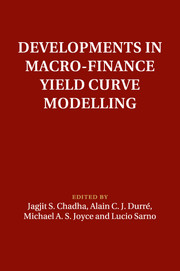Book contents
- Frontmatter
- Contents
- List of figures
- List of tables
- List of contributors
- Foreword
- Preface
- 1 Editors' introductory chapter and overview
- Part I Keynote addresses
- Part II New techniques
- 6 Compound autoregressive processes and defaultable bond pricing
- 7 Yield curve dimensionality when short rates are near the zero lower bound
- 8 The intelligible factor model: international comparison and stylized facts
- 9 Estimating the policy rule from money market rates when target rate changes are lumpy
- 10 Developing a practical yield curve model: an odyssey
- Part III Policy
- Part IV Estimating inflation risk
- Part V Default risk
- Index
9 - Estimating the policy rule from money market rates when target rate changes are lumpy
from Part II - New techniques
Published online by Cambridge University Press: 05 February 2014
- Frontmatter
- Contents
- List of figures
- List of tables
- List of contributors
- Foreword
- Preface
- 1 Editors' introductory chapter and overview
- Part I Keynote addresses
- Part II New techniques
- 6 Compound autoregressive processes and defaultable bond pricing
- 7 Yield curve dimensionality when short rates are near the zero lower bound
- 8 The intelligible factor model: international comparison and stylized facts
- 9 Estimating the policy rule from money market rates when target rate changes are lumpy
- 10 Developing a practical yield curve model: an odyssey
- Part III Policy
- Part IV Estimating inflation risk
- Part V Default risk
- Index
Summary
9.1 Introduction
Many Central Banks change their target (or policy) rates via discrete increments, typically multiples of 0.25%. Moreover, these changes almost always occur following scheduled meetings and the schedule of meetings is known well in advance to market participants. The intent behind this operational procedure is, or is understood to be, to increase the transparency of the Central Bank's actions and to reduce unnecessary variations in interest rates. Presumably, transparency increases the predictability of future policy rates, tightens the relationship of short-term yields to policy decisions and enhances the effectiveness of the monetary policy transmission mechanism. Indeed, a large literature has shown that short-term interest rates and, in the case of the US, Fed funds futures rates, provide the best forecasts of future target rates and can be used to estimate monetary policy shocks.
An accurate description of expectations as measured from short-term interest rates is crucial for policymakers and market participants. In the following, I compare dynamic term structure models for short-term interest rates that take into account the known schedule of policy meetings. One set of models is based on a discrete support, consistent with the fact that target changes take discrete increments, and another set of models is based on the standard Gaussian approximation. The sample is daily and runs until the end of 2011. A second set of results analyzes the information content of futures rates throughout the period where the target reached its lower bound in the US.
- Type
- Chapter
- Information
- Developments in Macro-Finance Yield Curve Modelling , pp. 216 - 250Publisher: Cambridge University PressPrint publication year: 2014

